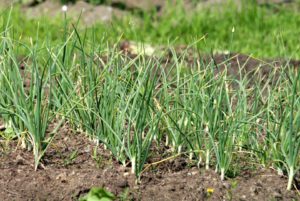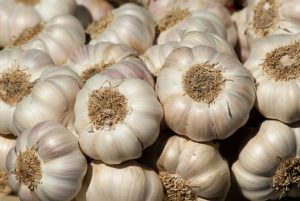How to Grow and Harvest Garlic Bulbs

Garlic has an intense flavor and is popular in the culinary world, this garden herb will take your recipes up a notch therefore it’s no wonder why garlic is a favorite. What also makes garlic widely accepted is its many uses for medical purposes.
Garlic herb dates back as far as ancient Egypt and India about 5000 years but it’s also believed to have originated from Western China and Northeastern Iran. Garlic (Allium sativum) belongs to the family Amaryllidaceae.
This perennial bulbous herb is easy to grow and care for, following this guide will give you the how-to on growing and caring for garlic so continue reading to learn more about planting and harvesting garlic bulbs.
Planting location
Garlic should be planted in a location that has lots of sunlight.
Soil requirements
The soil of garlic should be rich and well-drained, the roots of the cloves should be planted into the soil an inch or two deep. Each clove should be spaced about 6 to 8 inches apart with the rows being spaced 15 to 24 inches apart.
Watering methods
During the dry months, garlic should be watered deeply or thoroughly once a week. Allow the soil to dry before another water application.
Fertilizing methods
Adding compost around your garlic plants or broadcasting fertilizer over the entire bed will supply your garlic with the needed nutrients. Fertilizers high in nitrogen such as synthetics (man-made) or those containing blood meal is ideal.
Mulching garlic

Mulching garlic with straw will help in keeping the planting bed free of weeds while retaining moisture and will help to protect crops from winter damage. As the mulch decomposes will add nutrients to the soil.
Growing garlic in a container
Growing garlic in a container or pot can be a challenge because of needing to water more often, garlic can be planted anytime from September until November. Garlic planting should be carried out in the fall after the first frost but before the ground freezes.
The use of a large container that has drain holes is ideal, the larger the container the better because a large container will hold more soil that will, in turn, hold more moisture meaning you will water less making your job a lot easier.
Fill the container with well-drained rich soil or a potting mix, the container should be filled about 3 inches from the top. If using a potting mixture that doesn’t contain fertilizers then go ahead and add a slow-release fertilizer.
Next, remove or gently separated each clove, when placing the cloves in the soil each clove should be spaced about 3 inches apart with the pointed end up in the soil. Each clove should be planted no more than an inch or two deep.
Once the cloves have been placed at this depth cover with an inch of soil but in colder climates two inches of soil is ideal. Gently press the soil to firm each clove. The container should be placed in an area that gets about six hours of sunlight.
Give the soil a thorough soaking, allow the soil to dry out a bit but ensure that the soil is moist at all times and not saturated or waterlogged. During the warmer months or springtime, your garlic will sprout, during this time continue to monitor the soil moisture level along with fertilizing once every three weeks or thereabout.
Growing garlic indoors
Growing garlic indoors requires the same methods as you would do when planting in containers which can be found under the container section in this article only in the case smaller containers can be used. Once the container/containers are filled with soil plant your garlic cloves and water thoroughly. Place the container on a window sill that gets lots of sunlight. Continue to water and fertilize as laid out in this article.
Garden pests of garlic
Below are a group of listed pests but the proper control methods will bring elimination.
- Thrips
- Mites
- Nematodes
- Leaf miners
- Wheat curl mites
- Snails
Thrips – thrips do damage by sucking the plant’s sap, symptoms of thrips include slow growth of garlic and bulb production.
Mites – bulb mites are shiny and off-white in color, these garden pests can live from one growing season to the next and can be found in masses under the plant’s roots. Signs that your garlic crop is under attack by mites are stunting of the plant along with a poor yield
Nematodes – nematodes are worm-like microscopic pests living in the soil for many years and surviving without water. Nematodes feed on the entire plant, signs of nematodes include tissue collapse, discoloration, and deformation.
Leaf miners – leaf miners lay their eggs in the leaf tissues, once the eggs hatch the larva tunnels inside of the leaf. The larva is a tiny off-white, damage to the leaves is visible but not life-threatening.
Wheat curl mite – wheat curl mites are so tiny they a barely visible to the eyes, if your garlic cloves dry out along with leaves that are stunted and twisted this may be wheat curl mite infestation.
Snails – Snails can also be a threat to garlic, handpicking and throwing them in a bucket of soapy water will bring control.
Control measures
Crop rotation along with using organic pesticides will bring control, before using pesticides read and follow the manufacture’s label.
Diseases of garlic
Keep an eye out for these disease symptoms
- Fusarium root rot
- Rust
- White rot
Fusarium root rot – if an odor is emanating from your plant it may be a sign of fusarium. There is no cure except to remove and discard infected crops. Don’t plant in that location for at least two years, to avoid this disease crack the blubs of garlic and soak the cloves overnight with a solution of potassium bicarbonate.
Rust- the symptom appears as red pustules on the leaves, the use of potassium bi-carbonate or an organic copper spray may offer help.
White rot- which is caused by a fungus is devastating to garlic, symptoms include, stunted plant growth followed by yellowing and death of the outer leaves, more leaves are lost along with the central stems. Once the disease progresses there will also be stem rot above the bulb.
This disease is much more apparent on the blubs, white rot appears as a white fluffy growth on the roots and the root plate spreading upwards over the entire outer skin of the blub. Infected plants should be immediately removed and burn, the infected soil should be removed as well.
Harvesting and Storing garlic
When the lower leaves start to brown is a sign that garlic is ready to harvest but to be sure dig up a few of the blubs. If the cloves fill out the skin this is also another sign that garlic is ready to have. Garlic can be stored in a cool dry and dark place, frozen, or preserve in oil.
The final word on garlic
Growing and harvesting garlic is that simple from your garden to your kitchen is that easy. As stated earlier by following this guide will give you the know-how as you reap a reward of this herb that’s so popular. I love cooking with garlic because it’s amazing and you can to so go ahead and give it a try.
About the author
Norman loves being in the garden, both at home and for his job....
he is 'Natures Little helper' being outdoors, growing his vegetables and flowers from an early age.
Now having spent over 22 years in the profession he want to give some of his knowledge to others...
his vast array of hints and tips you will find scattered over this site will help you no end growing plants in your garden.

Hi Norman. Very interesting article. Im just starting my adventure with gardening and posts like this are extremely useful. I always wanted to have my own healthy food for family, and now with garden I can make my dream come true. And I can’t imagine kitchen without garlic, not only for meals but also as universal cure for cold. Looking forward to test your advices in practice, and hopefully I will see results this year.
Garlic is really amazing with so many benefits, so happy to hear you will be planting this wonder herb. Glad to help and wishing you all the best of success.
Thanks for this great article Planting garlic bulbs and for all the helpful tips and information on garlic.
Garlic is really a miracle plant because of all the good effects it has on our body.
We regularly use garlic as a food supplement and plant it every year, so these tips and recommendations in this article really benefit me. Thanks!
I wish you all the best
Nina
You are welcome and I am so happy to help, garlic is amazing and has so many benefits. All the best to you!!
I love garlic but have never thought to grow my own. You’ve piqued my interest now so I think I may try it. Your article was very thorough but I did have a couple of questions. When you say to plant a clove, would that mean that I would buy a head of garlic and split it into cloves and plant them? And that each clove would grow to a head of garlic? Also, does the ground have to freeze in order for them to produce? What if I live in a warm climate? I look forward to your answers so I can get started on my garlic patch!!
Yes, you can buy them and divide the cloves, however when purchasing ensure they are healthy. A good place to go is your plant nursery or farmer’s market. The answer is yes each clove can grow into a full head. Although garlic loves cool weather it is possible to grow them in climates that are a bit warmer even though this may be a challenge. Heirloom or gourmet cultivars such as Hardnecks, Creoles, and Asiatic are more suited for tropical areas. Hope this helps and please let me know how it goes.